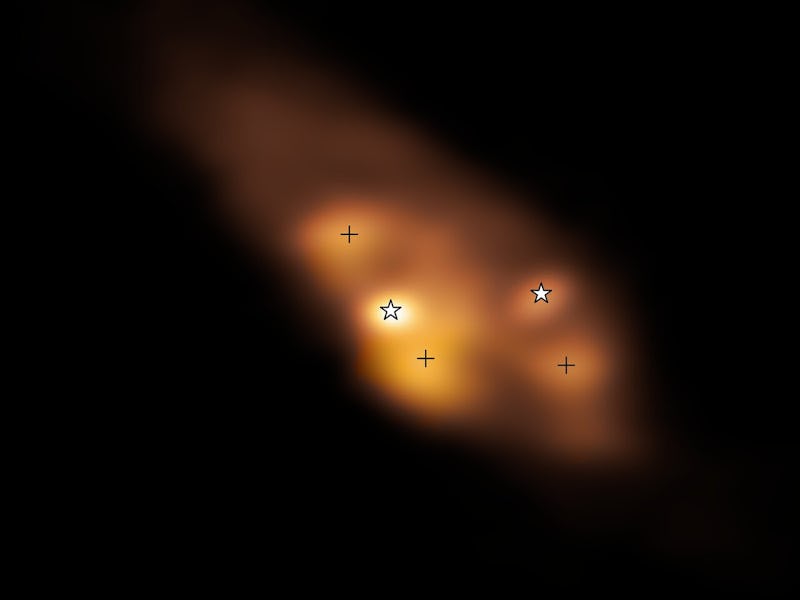Astronomers catch two clashing protostars building the ingredients for life
A close-knit pair of newborn stars are kicking up shock waves — and seeding the material of their future planets with organic molecules.

The Atacama Large Millimeter/submillimeter Array recently imaged a pair of very young protostars — newborn stars in the first few hundred thousand years of their lives, still feeding on a nearby disk of gas and dust that surrounds the stars.
What’s New — Astronomers noticed that three spots in the stars’ disk looked unusually hot. Data from other telescopes showed that two of the three hotspots also had more organic molecules than the rest of the cloud.
In a recent study, astrophysicist María José Maureira, of the Max Planck Institute for Astronomical Physics, and her colleagues suggest that shock waves from the two closely-orbiting protostars heated these patches of dust — and created the right conditions for organic molecules to form, seeding the building blocks of a solar system with organic chemistry.
The astrophysicists recently published their work in the Astrophysical Journal Letters.
The star symbols in this image (created from ALMA’s measurements of radio wavelengths coming from the star system) mark the two young stars. The three plus signs are the hotspots in the stars’ accretion disk.
Digging Into The Details — The two protostars share an unwieldy name (IRAS 16293-2422 A) and a very close orbit around their common center of gravity. They’re just 54 astronomical units apart, or 54 times the distance between Earth and the Sun. For comparison, Pluto is an average of 39 astronomical units away from the Sun, which sounds like a vast distance when you’re talking about a dwarf planet — but it suddenly sounds very crowded if you’re talking about a second star.
Because the two young stars, A1 and A2, orbit so close to each other, the gravity situation in their neighborhood is pretty complex, and simulations suggest that it can produce powerful, fast-moving shock waves in the disk of gas and dust surrounding them. Picture two huge fish swimming around each other in a pond, stirring up ripples. As a bonus, these young stars are still feasting on the material that’s close by — and stars are messy eaters, occasionally flinging rejected morsels out into the surrounding disk of gas and dust. That also creates shock waves in the disk.
As those shock waves pass through the cloud of gas around the two young stars, the gas becomes compressed. That does two things: first, it heats the gas, and second, it squishes molecules into a tighter space, giving them a chance to connect and form more complex molecules. And when dust grains collide with the heated gas, the dust gets hotter, too.
The hotspots that ALMA spotted are too far from the protostars to be getting all their heat from radiation, but according to Maureira and her colleagues, their locations and temperatures match exactly what models predict should happen when shockwaves heat up the disk of material around the stars.
In other words, the two closely-circling infant stars at the heart of the dusty disk are sending ripples through the disk that leave a trail of hotspots and chemical reactions in their wake.
The ALMA array
Why It Matters — Some of the molecules produced by those chemical reactions include isocyanic acid, which is the simplest possible combination of hydrogen, nitrogen, carbon, and oxygen, the four elements that make up organic molecules. Thanks to the kickstart provided by the shockwaves moving through the disk, the solar system taking shape around A1 and A2 is seeded with complex organic molecules very early in its evolution. And some of those molecules could eventually become the building blocks for life.
No planets have taken shape from the cloud of dust and gas quite yet; the star system is in the first 500,000 years of its life, but according to another recent study, the building blocks of planets — small clumps of dust called planetesimals — may start to coalesce from the disk of material around A1 and A2 in the relatively-near future. And shockwaves from the two protostars at its center may play a role in shaping how planets eventually form.
“The high temperatures in these shocks can also alter how dust particles stick together, changing how early the formation of planetary cores can occur,” says the European Southern Observatory in an announcement.
This article was originally published on